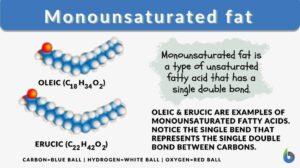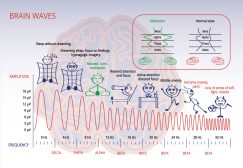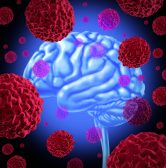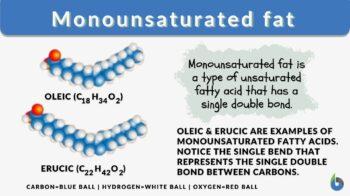
Monounsaturated fat
n., plural: monounsaturated fats
[ˈmɒn.əʊ ʌnˈsætʃəˌreɪtɪd fæt]
Definition: a type of unsaturated fatty acid that has a single double bond
Table of Contents
What is monounsaturated fat? Monounsaturated fats are healthy dietary fats. They are liquid at room temperature. Unlike saturated fats, monounsaturated fats do not increase the risk of heart diseases and don’t cause health issues when consumed in moderate amounts instead of saturated or trans fats. Is monounsaturated fat healthy? Let’s find out below.
Monounsaturated Fat Definition
Monounsaturated fat is the fat in which its fatty acid molecules contain one unsaturated double bond, the melting point of monounsaturated fats is less than that of saturated fats, they are liquid at room temperature. They are found in nuts, vegetable oils, avocados, and fish. Monounsaturated fats are healthy fats that should be consumed moderately to maintain a healthy heart.
Monounsaturated fatty acids foods form healthy fats, which can help people to control their weight and support the heart. However, monounsaturated fats are rich in calories as each gram contains nine calories. So they can increase weight when consumed in large amounts. Saturated and unsaturated fats are natural fats found in animals or plants.
Monounsaturated fat examples are natural fats extracted from plant foods such as avocados, nuts, and vegetable oils. Olive oil is one of the healthiest fats which consists of fatty acids with double unsaturated carbon bonds.
Monounsaturated fat is an unsaturated fatty acid that contains only one double or triple bond in the carbon chain. It is believed to be a dietary fat that helps reduce LDL cholesterol in the blood. Foods rich in monounsaturated fats are almonds, peanut oil, olive oil, canola, and avocados.Etymology: mono- (single)
Abbreviation: MUFA
Also called: monounsaturated fatty acid
Compare: polyunsaturated fat
See also: fat (nutrition)
Watch this vid about monounsaturated fats:
Health Effects
Does monounsaturated fat raise cholesterol? Monounsaturated fats have beneficial effects on the health since they can lower blood cholesterol levels, reduce inflammation, improve the rhythm of the heart, reduce blood pressure, improves overall lipid profile, faster clearance of fats, less storage of fats, reduce fasting triglycerides, reduces coagulopathy, and decreases the estimated percentage of developing cardiovascular disease, along with other beneficial roles. Moreover, type 2 diabetic patients can benefit from monounsaturated fats since they have the ability to reduce risk factors of triglycerides, systolic blood pressure, total body weight, and fasting blood glucose.
Omega-3 fats are polyunsaturated fat that must be consumed from food since the body doesn’t have the ability to synthesize them. Omega-3 fats are available in fish, walnuts, flaxseed, and soybean oil. According to the HSPH faculty, as the percentage of omega-3 fats in the blood increases, the risk of premature death among adults decreases.
Eating monounsaturated fat foods instead of carbohydrates increases levels of HDL cholesterol (high-density lipoproteins) which are cardio-protective and lowers the risk of developing heart disease and stroke. On the other hand, it decreases levels of LDL cholesterol (low-density lipoproteins) which have harmful effects on the heart and blood vessels. Besides their beneficial effects on the heart and vessels, monounsaturated fats provide the body with essential fats used by cells for nutrition as the cell membrane is mainly composed of phospholipids, it also contributes to the absorption and synthesis of fat-soluble antioxidant vitamins, such as vitamin A, K, E, and D.
Monounsaturated fats affect the synthesis of lipid-derived hormones like sex hormones, which regulate and control sexual characters, aldosterone, which controls the balance of salts and water, and cortisol, which have important functions such as reducing inflammation, regulating blood pressure, and controlling sleep cycle.
Sources of Monounsaturated Fat
Examples of foods high in monounsaturated fat are:
- Canola oils consist of 62% monounsaturated fatty acids and are used for frying, baking, and in salad dressings.
- Olive oil contains 73% monounsaturated fats. It is used for salads, vegetables, appetizers, and dips.
- Hazelnuts, almonds, and pecans. almonds have a low glycemic index, therefore, they are helpful for patients with insulin resistance. Almonds can also lower certain blood lipids.
- Peanut and olive
- Sesame and pumpkin seeds. Seeds are composed of lipid concentrated calories, fiber, carbohydrates, proteins, and phytonutrients. Pumpkin seed is used to make granola, cereal, and salads. Whereas sesame seed is used to make garnish, cakes, salad, and breadstuff.
- Avocados
- Sesame and safflower oils
- Peanut butter
Oleic acid is one of the most common monounsaturated fatty acids (MUFAs). Other common types of MUFAs are palmitoleic acid, and vaccenic acid. However, oleic acid represents about 90% of dietary MUFAs. Oleic acid is also known as omega-9 fatty acid, it can either be produced naturally by the body or obtained from oils such as sunflower oil, canola oil, and olive oil which is the most important source of oleic acid. Palmitoleic acid is mainly found in eggs, moreover, chicken eggs also contain oleic acid.
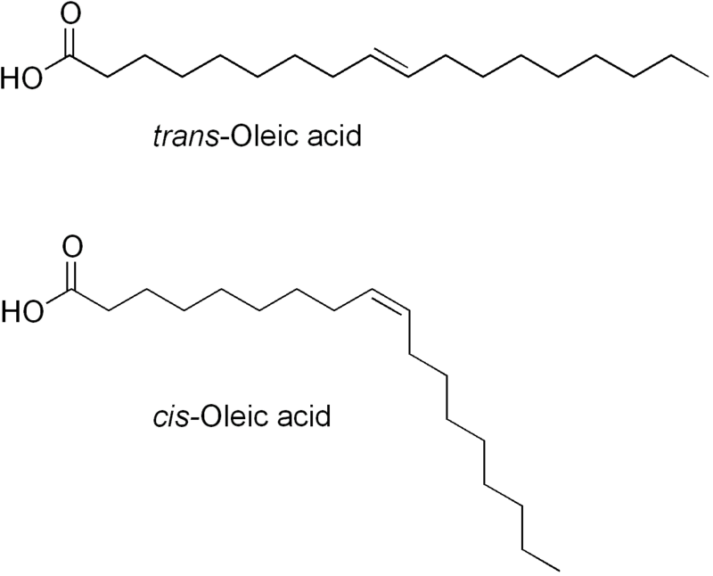
Olive oil is a major component of the Mediterranean diet. Therefore, people following this diet have a lower incidence of obesity, inflammation, and cardiovascular diseases. It is abundant in oleic acid, which is a monounsaturated fatty acid. Olive oil is a healthy dietary fat that contains nine calories per gram like other fatty foods
How Much to Eat
Unsaturated fatty acids have several health benefits. However, you should have low fat diets since fats contain nine calories per gram. Saturated and trans fats are precursors of cholesterol synthesis. Therefore, you should replace saturated fats with polyunsaturated and monounsaturated fats as health benefits are obtained by the consumption of unsaturated fats. Replacing unhealthy fats will result in better weight control, reduced risk of heart disease, and a healthy lifestyle.
The amount to be consumed from fat-rich food depends on the type of fats where trans fats should be avoided completely. The American Heart Association recommends limiting trans fat consumption to less than 1% of daily caloric intake. Whereas, Saturated fats consumption should not be more than 10% of the total daily calorie intake. However, it is recommended to replace saturated fat with unsaturated fat in your daily fats intake. On the other hand, unsaturated dietary fatty acids consumption may reach 25 to 30% of your total daily calories since it’s the healthiest type of fat.
Unsaturated fats may either be monounsaturated fats or polyunsaturated fats. Monounsaturated fatty acids examples are oleic acid in olive oil and palmitoleic acid in macadamia nuts.
Frequently Asked Questions
What are the sources of fats?
There are many sources of monounsaturated fat as some fats come from animal sources such as fish, or from plant foods such as avocados, vegetable oils, and nuts.
What are the types of fats?
There are 3 types of fats which are unsaturated, saturated, and trans fats. The difference between saturated and unsaturated fatty acids is discussed in the following table as well as trans-fats.
Table 1: comparison between unsaturated, saturated and trans fats | ||
|---|---|---|
| Unsaturated Fats | Saturated fats | Trans fats |
| They are mainly found in plant foods and vegetable oils such as olive oil. There are two types of unsaturated fats: monounsaturated and polyunsaturated fats. | Dietary saturated fat mainly comes from animal sources such as beef, dairy products, and poultry. | They are usually artificial fats produced in industries that aim to solidify liquid oils such as vegetable oils. Trans fatty acids are unhealthy fats, they are found in cheese, fast food, cookies, and sausage. |
| Healthy fats that contain one or more unsaturated bonds in their chemical structure | Fats that do not contain any double bonds in their chemical structure | Trans fat is an artificially hydrogenated fat |
| Unsaturated fat is essential to be used in moderate amounts due to its health benefits. | Saturated fat must be consumed in small amounts | Should not be used as it increases the risk of heart disease. |
Data Source: Nadine Omar of Biology Online
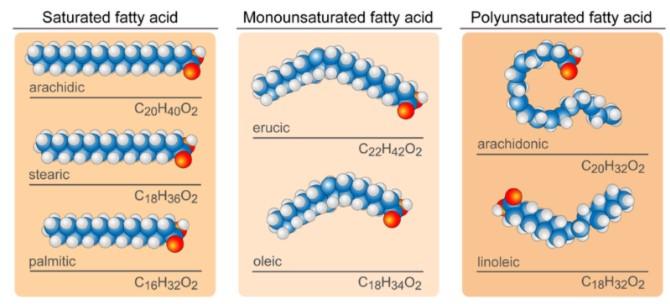
Is monounsaturated fat good?
monounsaturated fat benefits are numerous, as it decreases the risk factors for developing cardiovascular diseases, helps in losing weight, slows down aging, boosts digestion and metabolism, decreases levels of bad cholesterol, prevents gallstones, prevents several types of cancers, and promotes a healthy living.
What are natural fats?
Both saturated and unsaturated fats are natural fats, however, saturated fats are precursors of cholesterol synthesis. Thus, their consumption should be minimized to avoid atherosclerotic and heart diseases.
Answer the quiz below to check what you have learned so far about monounsaturated fats.
References
- Cherian, G. (2009, March 18). Eggs and health: Nutrient sources and supplement carriers. Complementary and Alternative Therapies and the Aging Population. Retrieved June 3, 2022, from https://www.sciencedirect.com/science/article/pii/B9780123742285000160
- Fats and cholesterol. The Nutrition Source. (2019, May 22). Retrieved June 3, 2022, from https://www.hsph.harvard.edu/nutritionsource/what-should-you-eat/fats-and-cholesterol/
- Marcus, J. B. (2013, November 6). Lipids basics: Fats and oils in foods and health: Healthy lipid choices, roles and applications in nutrition, Food Science and the Culinary Arts. Culinary Nutrition. Retrieved June 3, 2022, from https://www.sciencedirect.com/science/article/pii/B9780123918826000066
- MediLexicon International. (n.d.). Monounsaturated fat: Benefits and sources. Medical News Today. Retrieved June 3, 2022, from https://www.medicalnewstoday.com/articles/monounsaturated-fat#health-effects
- Monounsaturated fat. www.heart.org. (2021, January 13). Retrieved June 3, 2022, from https://www.heart.org/en/healthy-living/healthy-eating/eat-smart/fats/monounsaturated-fats
- Robertson, R. (2017, September 19). What are the benefits of monounsaturated fats? Healthline. Retrieved June 3, 2022, from https://www.healthline.com/nutrition/monounsaturated-fats
- Schwingshackl, L., & Hoffmann, G. (2014, October 1). Monounsaturated fatty acids, olive oil and health status: A systematic review and meta-analysis of Cohort studies. Lipids in health and disease. Retrieved June 3, 2022, from https://www.ncbi.nlm.nih.gov/pmc/articles/PMC4198773/
- Types of fat. The Nutrition Source. (2018, July 24). Retrieved June 3, 2022, from https://www.hsph.harvard.edu/nutritionsource/what-should-you-eat/fats-and-cholesterol/types-of-fat/
- U.S. National Library of Medicine. (n.d.). Facts about monounsaturated fats: Medlineplus medical encyclopedia. MedlinePlus. Retrieved June 3, 2022, from https://medlineplus.gov/ency/patientinstructions/000785.htm
©BiologyOnline.com. Content provided and moderated by Biology Online Editors.

